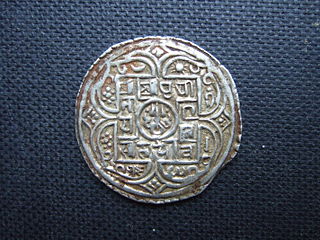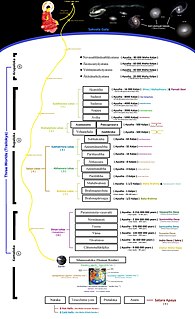The wheel of time or wheel of history is a concept found in several religious traditions and philosophies, notably religions of Indian origin such as Hinduism, Jainism, Sikhism, and Buddhism, which regard time as cyclical and consisting of repeating ages. Many other cultures contain belief in a similar concept: notably, the Q'ero Natives of Peru, as well as the Hopi Natives of Arizona.
The Kali Yuga, in Hinduism, is the fourth and worst of the four yugas in a Yuga Cycle, preceded by Dvapara Yuga and followed by the next cycle's Krita (Satya) Yuga. It is believed to be the present age, which is full of conflict and sin.
A yuga, in Hinduism, is generally used to indicate an age of time.

Tathāgata is a Pali word; Gautama Buddha uses it when referring to himself or other Buddhas in the Pāli Canon. The term is often thought to mean either "one who has thus gone" (tathā-gata), "one who has thus come" (tathā-āgata), or sometimes "one who has thus not gone" (tathā-agata). This is interpreted as signifying that the Tathāgata is beyond all coming and going – beyond all transitory phenomena. There are, however, other interpretations and the precise original meaning of the word is not certain.

The Indian national calendar, sometimes called the Saka calendar, is used, alongside the Gregorian calendar, by The Gazette of India, in news broadcasts by All India Radio and in calendars and communications issued by the Government of India.

The Treta Yuga, in Hinduism, is the second and second best of the four yugas in a Yuga Cycle, preceded by Krita (Satya) Yuga and followed by Dvapara Yuga. Treta Yuga lasts for 1,296,000 years.
Hindu eschatology is linked in the Vaishnavite tradition to the figure of Kalki, or the tenth and last avatar of Vishnu names of the Supreme Being in Hinduism and before the age draws to a close, and Harihara simultaneously dissolves and regenerates the universe.

The Satya Yuga, in Hinduism, is the first and best of the four yugas in a Yuga Cycle, preceded by Kali Yuga of the previous cycle and followed by Treta Yuga. Satya Yuga lasts for 1,728,000 years.

The Dvapara Yuga, in Hinduism, is the third and third best of the four yugas in a Yuga Cycle, preceded by Treta Yuga and followed by Kali Yuga. Dvapara Yuga lasts for 864,000 years.
Hindu cosmology is the description of the universe and its states of matter, cycles within time, physical structure, and effects on living entities according to Hindu texts. Hindu cosmology is also intwined with the idea of a creator who allows the world to exist and take shape.

The Saptarishi (from Sanskrit: सप्तर्षि , a Sanskrit dvigu meaning "seven sages"; Sapta or Saptan - seven, Rishi - sage are the seven rishis in ancient India, who are extolled at many places in the Vedas and other Hindu literature. The Vedic Samhitas never enumerate these rishis by name, though later Vedic texts such as the Brahmanas and Upanisads do so.
Pralaya, in Hindu cosmology, is an aeonic term for dissolution.
The Brahmajāla Sutta is the first of 34 suttas in the Dīgha Nikāya. The name means Net of Brahmā. The sutta is also called 'Atthajala', Dhammajala,, Ditthijala, Anuttarasangama Vijaya.

Buddhist cosmology describes the planes and realms in which beings can be reborn. The spatial cosmology consists of a vertical cosmology, the various planes of beings, into which beings are reborn due to their merits and development; and a horizontal cosmology, the distribution of these world-systems into an "apparently" infinite sheet of "worlds." The temporal cosmology describes the timespan of the creation and dissolvement of universes in aeons. Buddhist cosmology is also intwined with the belief of karma, and explains that the world around us is the product of past actions. As a result, some ages are filled with prosperity and peace due to common goodness, whereas other eras are filled with suffering, dishonesty and short lifespans.
A manvantara, in Hindu cosmology, is a cyclic period of time identifying the duration, reign, or age of a Manu, the progenitor of mankind. In each manvantara, seven Rishis, certain deities, an Indra, a Manu, and kings are created and perish. Each manvantara is distinguished by the Manu who rules/reigns over it, of which we are currently in the seventh manvantara of fourteen, which is ruled by Vaivasvata Manu.
Hindu units of time are described in Hindu texts ranging from microseconds to trillions of years, including cycles of cosmic time that repeat general events in Hindu cosmology. Time is described as eternal. Various fragments of time are described in the Vedas, Manusmriti, Bhagavata Purana, Vishnu Purana, Mahabharata, Surya Siddhanta etc.

In the oldest texts of Buddhism, dhyāna or jhāna is a component of the training of the mind (bhavana), commonly translated as meditation, to withdraw the mind from the automatic responses to sense-impressions, and leading to a "state of perfect equanimity and awareness (upekkhā-sati-parisuddhi)." Dhyāna may have been the core practice of pre-sectarian Buddhism, in combination with several related practices which together lead to perfected mindfulness and detachment.
In India, the Teluguyear is the calendar year for the Telugu speaking people of Andhra Pradesh and Telangana states.
A Yuga Cycle is a cyclic age (epoch) in Hindu cosmology. Each cycle lasts for 4,320,000 years and repeats four yugas : Krita (Satya) Yuga, Treta Yuga, Dvapara Yuga, and Kali Yuga.








